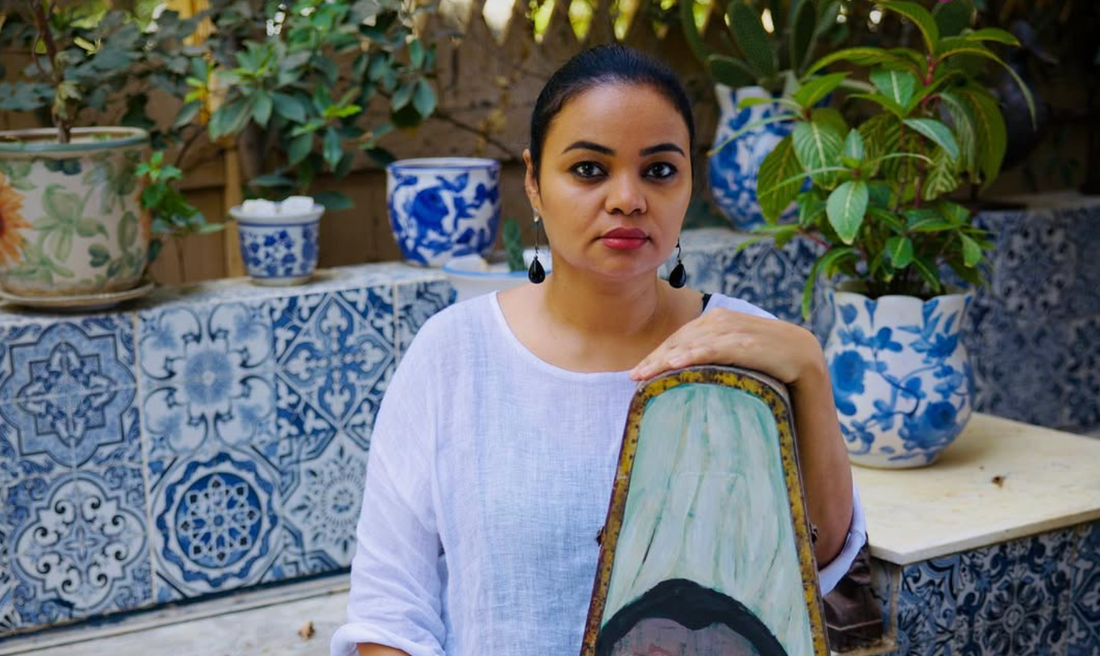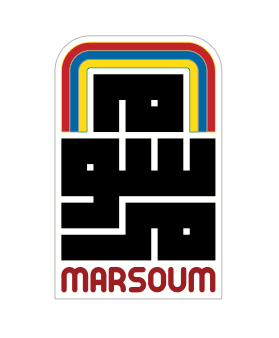
Souad Abdelrasoul: Mapping the Body, the Earth, and the Self
Share
Born in 1974 and based in Cairo, Abdelrasoul’s work offers a deeply original voice in contemporary Arab art. Over the past two decades, she has built a practice that is rigorous, layered, and often haunting. We’ve seen Abdelrasoul’s work explore themes of identity, gender, memory, and embodiment through a symbolic visual language that draws as much from ancient cosmology and anatomy books as it does from personal experience.
Her canvases, filled with distorted figures, veiled symbols, and mythic landscapes, don’t just present images. They present worlds. Worlds that are part archive, part body, part dream.

A Life Shaped by the Nile
Abdelrasoul’s connection to the concept of place (particularly to Cairo and the Nile) is foundational to her work. Raised in Shubra, a historically cosmopolitan district on the banks of the river, her early years were marked by a rich, if complex, exposure to Egypt’s cultural layers. She later studied at Minia University in Upper Egypt, earning a degree in Fine Arts, followed by a Master’s and PhD in Art History from Helwan University.
This trajectory from Shubra to Minia, and back to Cairo mirrors the emotional and spiritual journeys she stages on canvas: moving through tradition, rebellion, and ultimately, self-discovery.
Water, especially the Nile’s, is a frequent metaphor in her work. In her words,
“The river is me… my journey through life.”
It’s a symbol of purification and possibility, but also of danger and dissolution.
Between Body and Map
Abdelrasoul’s practice is as conceptual as it is formal. Across her drawings and paintings, she depicts metamorphosed bodies, often female, merged with elements of flora, fauna, and sometimes anatomical structures. These hybrid forms seem pulled from an internal atlas, reconfiguring veins into branches, faces into topographies, or spines into rivers. In fact, many of her early works were directly drawn over anatomy books and maps.

“I’ve been drawing on maps and anatomy books… since 2008,” Abdelrasoul writes. “These shapes were the keys that reshaped the faces and the bodies of my characters that don’t resemble anyone.”
This visual strategy destabilizes fixed identities. It blurs the lines between human and nonhuman, personal and political, seen and unseen. And it reflects Abdelrasoul’s broader project:
to reclaim a space for the feminine body. Not just as subject, but as landscape, archive, and resistance.
Feminine Power Without Apology
Though often labeled as feminist, Abdelrasoul resists narrow interpretations of her work. “My art is not about feminism,” she has said. “It’s about the human experience.” Still, it is impossible to separate her aesthetic from her exploration of gendered oppression, particularly in Arab societies. Abdelrasoul’s paintings challenge dominant narratives around beauty, sexuality, and female agency. They are populated with women who are fragmented yet whole, constrained yet defiant.
In works like “The Fear Between My Legs” (2022), she confronts taboos surrounding the body and sexuality, especially the idea (still prevalent in parts of society) that a woman’s honor is tied to her virginity.

In others, such as “Last Look at Fear”, her subjects reclaim their autonomy, casting off the metaphoric “rabbits” of societal fear to emerge strong, present, and in control.

Souad’s women are not idealized or objectified. They’re symbolic, wounded, raw, and they always insist on being seen.
Art as Personal Rebellion
Abdelrasoul’s journey as an artist is also a journey of survival and resistance. Her decision to leave Cairo and study in Upper Egypt was her first act of rebellion against the patriarchal structures of her family and society. Later, she would navigate the profound loss of her mother, a moment that deepened her turn inward and intensified her creative practice.
In her graduation project, she took on the historically Orientalist theme of women in bathhouses. But instead of romanticizing it, she reimagined it from the inside, drawing her models from life and situating them in a space marked by poverty, humidity, and real emotion. Her willingness to explore the nude body, especially as a woman in a conservative environment, was nothing short of radical.
She has since developed a visual language rooted in what has been described as “magical psychological realism”, where the body is both subject and metaphor, both symbol and sensation.

Notable Exhibitions & Recognition
Abdelrasoul has exhibited extensively, both locally and internationally. Her solo shows: Virtual Garden (Cairo, 2019), Behind the River (Nairobi, 2021), and Atlas (Cairo, 2023), each mark a chapter in her evolving artistic vision. In Virtual Garden, she explored “soft” constraints like memory and motherhood through botanical symbolism. In Behind the River, she began confronting fear directly. And in Atlas, she worked to dispel fear altogether, offering instead a gesture toward peace and self-reconciliation.
Her work has been shown at major international fairs including 1-54 Contemporary African Art Fair, Art Dubai, Investec Cape Town Art Fair, and the prestigious Armory Show in New York. She is represented in the collections of the Worcester Art Museum, Chazen Museum of Art, and Museum of Modern Art in Cairo, among others.
Abdelrasoul was also featured in the landmark Phaidon publication Great Women Painters (2022).

The Logic of Her Own World
Abdelrasoul’s work demands and rewards close attention. As writer and critic Fatima Ali observed, her paintings are not meant to be read literally. Their power lies in suggestion, in the slow unraveling of associations between form, color, and emotion. Faces appear distorted, sometimes split into multiple identities. Bodies morph into animals or merge with trees. Her use of transparency, layering, and color creates surfaces that are charged with both visual and psychological depth.
Abdelrasoul has described her process as “an internal and self-motivated inspiration… from a distant point in my soul.” Her art, then, is not about representation—it is about revelation.

Souad and Marsoum
In joining Marsoum, Abdelrasoul becomes part of a collective that shares her commitment to telling stories of the Arab world that celebrate its rich heritage and contemporary identity, beyond stereotypes and simplifications. Her work brings a deeply introspective, poetic, and at times uncomfortable gaze to the surface, precisely the kind of complexity we’re honored to support and showcase.
To encounter her art is to face both tenderness and trauma, the body and the cosmos, fear and liberation. It is to be reminded that the personal is always political, and that even in fragmentation, there is beauty.

